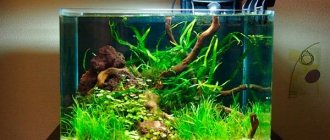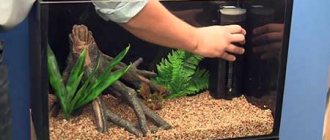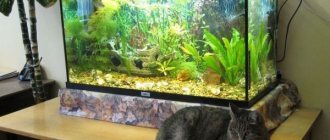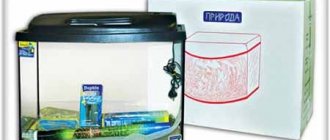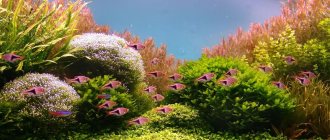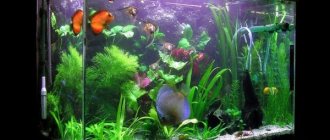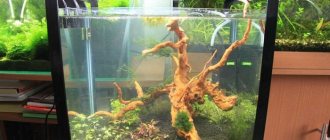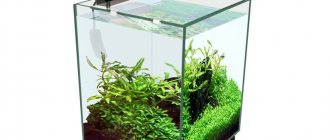Home › Aquarium equipment ›
( 5 ratings, average: 4.80 out of 5)
An aquarium with a volume of 20 liters is a very small aquarium, or as they often say now “nano aquarium”, but still it is no longer a 10 liter aquarium. In such a small volume of water, it is still difficult to establish a stable biological environment, it is difficult to avoid overpopulation, and the water temperature greatly depends on the temperature in the room, but there are now more opportunities in choosing plants, decorations, fish and shrimp. How to properly equip such an aquarium, how much soil is needed, what kind of lighting to choose, plants to plant, and fish to live in?
Choosing an aquarium
Aquariums with a volume of 20 liters are affordable and simple in technical equipment.
There are several different forms:
- Rectangular designs are the most popular. These are classic options with dimensions of 39 x 27.5 x 32 cm, 41.5 x 27.5 x 20.5 cm, 38 x 26 x 37 cm.
- Round aquariums with a diameter of 33-35 cm and a height of 25-27 cm fit perfectly into a modern interior. Such tanks with frozen air bubbles in the thickness of the glass look interesting.
- Cubic-shaped ponds will appeal to lovers of Art Nouveau style interiors. The focus shifts from aquarium contents to configuration.
It is believed that a rectangular structure is more convenient to design. In such an aquarium it is easier to place plants and create an atmosphere of the underwater world.
Shape and size options
On sale you can find small-sized 20 liter aquariums in a variety of designs, configurations and sizes. The most popular are square and rectangular tanks.
Rectangular aquariums with a capacity of 20 liters are considered a classic version of tanks designed for arranging small home ponds. The most popular among them are designs measuring 38x26x37, 39.5x28x33, 39x27.5x32, 41.5x27.5x20.5 centimeters.
A classic round aquarium will fit organically into the interior of a modern apartment. Typically, the diameter of such tanks varies between 33-35 centimeters, height – between 25-27 centimeters.
Round tanks with frozen air bubbles in the thickness of the glass walls look very impressive.
In the interiors of apartments made in the Art Nouveau or Art Nouveau style, disc-shaped aquariums , shaped like a car wheel, will look very organic. Another interesting option for stylish interiors are tanks, the bottom of which has the shape of a trapezoid or hexagon with rounded edges. The average height of disc-shaped and trapezoidal aquariums for 20 liters usually reaches 38-40, width - 25-35 centimeters.
Water preparation
High-quality prepared water is the key to the successful launch of a home pond. It should not contain mechanical suspensions, chlorine, or other elements harmful to fish and plants. Tap water should be left to stand for 1-2 days in a separate container. If it is not possible to wait this time, you can purchase a special air conditioner. It is added in the proportions specified in the instructions for a particular drug.
Water has the ability to evaporate. Therefore, you need to have a supply of settled water for topping up and changing. One option is to add water to a small reservoir from a larger one. The advantage is that the necessary microflora for aquatic life is not disturbed.
How to choose?
Before purchasing a 20-liter aquarium, experienced aquarists recommend deciding on the shape of the tank. Many beginners and amateurs find round aquariums the most attractive. However, such tanks have a number of disadvantages, which some inexperienced aquarists are not even aware of.
Thus, round aquariums, due to their shape, greatly distort the contents of their internal space . Fish and plants in round tanks often appear disproportionate and unnaturally large.
In addition, according to experienced aquarists, fish often experience discomfort in round tanks. The lack of corners most often does not allow them to feel safe.
The best option for a beginner, according to experienced aquarists, would be a rectangular or square aquarium. Fans of unusually shaped designs may prefer polygonal or trapezoidal tanks.
Acrylic glass aquariums are considered the most practical and inexpensive. It has been noticed that they retain heat 20% better than conventional glass containers. Thus, in operation, aquariums with acrylic glass may be more economical in terms of water heating costs. However, their disadvantages include vulnerability to mechanical damage, which can be caused by a hard scraper or wire brush.
Glass aquariums are among the most hygienic and durable, but expensive structures , vulnerable primarily only to strong impacts and falls. They are easier to care for, easier to clean from algae deposits, and to disinfect.
When choosing a 20-liter aquarium, it is worth considering such criteria as:
- environmental friendliness of materials (body, glazing);
- tightness of joints;
- wall thickness and transparency;
- integrity and weight of the structure itself.
Priming
The role of good soil in an aquarium is enormous. This is the basis for beneficial microorganisms that form the water biobalance, processing waste products of organisms, acting as natural biofilters.
Neutral ground options:
- granite chips;
- river pebbles;
- basalt chips;
- coarse sand;
- quartz.
The bottom of the tank should be covered with 30-40 mm of soil. On average, 4 kg of gravel is required. ADA, Manado and Dennerle nutrient soils are suitable for a 20 liter aquarium. Simpler pebbles should have a fraction of 1-5 mm.
Filters and heaters
Water heaters are required in cases where the room temperature drops below +21°C or if fish accustomed to a tropical climate live in an artificial reservoir.
Disadvantages of cheap heaters. For a small tank you will need a high-quality heater with good thermoregulation performance. Cheap devices do not regulate temperature well, which in a small artificial reservoir can lead to the death of aquarium inhabitants and green spaces in case of overheating.
Selection of filter devices . When choosing a filter, problems may arise, since most types of such equipment are not suitable for nano-aquariums. Due to their great power, they create too intense a current, which carries away fish and harms plant crops. An airlift filter, which you can make yourself or purchase in specialized stores, will help solve the problem.
The average filter capacity for a 20 liter aquarium should be about 60-80 liters per hour.
The ideal option for nano-aquariums is hanging external filters that do not take up much space in an already small artificial reservoir.
Decor
The design of a 20 liter aquarium is different from that which can be created in a large home pond. You should not install bulky structures in such reservoirs. Any additional decorations and thickets of plants reduce the volume of an already small aquarium. Therefore, aquadesign in this case should be focused on placing decorations in the corners, and not in the center.
A beautifully designed underwater world may include:
- small stones;
- driftwood;
- plants, mosses.
It is better to choose a background film in light colors. The plot should have a perspective in order to visually expand the boundaries of space. When thinking about the design of a 20-liter aquarium, you need to take into account that small viviparous fish such as guppies prefer natural plants, and selected breeds feel fine surrounded by artificial decorative elements.
Review of manufacturers
Among the most famous manufacturers of aquariums and aquarium complexes there are both foreign and domestic companies. The largest leaders in this market segment include the following brands:
- Aquael;
- Aquas;
- Tetra.
Aquael is a well-known Polish company that produces both classic rectangular and polygonal, round and panoramic aquariums of various sizes. The manufacturer usually includes sets of auxiliary equipment with tanks - filters, heaters, lamps. The structures also come with products for preparing water and feeding aquarium plants.
Aquas is a Russian manufacturer that produces aquariums for apartments and offices. In the manufacture of its products, the company uses high-quality components and materials of foreign origin - for example, high-strength Pilkington glass (England), German silicone sealants. It is noteworthy that the price of tanks of this brand is quite reasonable.
Tetra is a German brand that produces food for aquarium fauna, aquarium care products, as well as small aquariums with a capacity of 20 to 130 liters. The bodies of 20 liter tanks produced under this brand are presented in 2 colors - dark and light.
Equipment
In order for a 20-liter aquarium to function normally, and for its inhabitants to feel comfort and safety, it is necessary to purchase the following equipment:
- Filter. Without it, the pond will quickly become dirty. It is advisable to select remote devices to save space.
- Compressor for saturating the aquatic environment with oxygen. Such a device is especially necessary when it is decided to use artificial plants instead of living ones.
- A thermometer is a must-have item for monitoring water temperature. Most phenotypes require temperature maintenance of 22 –26℃. But there are breeds of fish that like cold or very warm water
- Heater. There is a need for such equipment if the aquarium is located in a cold room or the aquatic inhabitants are heat-loving species.
- Lighting. The quantity, power and other characteristics depend on the type of fish. Some people need bright and cold light, others warm and muted.
It is also advisable to have testers to measure the level of hardness and acidity.
On a note! An economical equipment option is to replace the filter and compressor with an internal filter with an aeration option.
Ecologically clean living environment
The water in any aquarium should be clean, not contaminated with bacteria and harmful microorganisms, of moderate hardness, without chlorine and excess heavy metals, and saturated with oxygen.
To ensure that the water is soft and free of harmful chlorine, it is left to stand in an open container (for example, an enamel bucket or large saucepan) for 1 day, then boiled, cooled to room temperature and poured into the aquarium. In the future, you can simply add distilled water to the aquarium.
It is necessary to plant beneficial algae in the aquarium. Elodea algae fights well against harmful excess heavy metals. They accumulate zinc especially intensively. Vallisneria is good at purifying water from rust.
Plants
For a 20-liter aquarium, you can choose both floating plants and those intended for planting in the ground. The most suitable are the following:
- Duckweed. It can often be seen in standing natural reservoirs. You can collect a small amount. After 40-50 days, the surface of the aquarium will be covered with this plant. Goldfish love to snack on duckweed for their lunch.
- Riccia. It looks like miniature trees intertwined with each other. The plant clings to the walls of the tank, creating original decorations.
- Hygrophiles are unpretentious species of algae. They do not require special attention from the aquarist. They are planted in the ground at the back of the reservoir. If you place a plant near the front wall, it will block your view with its flowering.
- Indian fern with finely dissected leaves is one of the most beautiful underwater plants. The bushes are planted as a frame for the composition on the sides of the tank.
- Java moss is suitable as a mini-decoration for a pond with any soil, since it is not important for it. Will grow on snags and stones. Fry and crustaceans love to hide in moss.
- Hornwort attracts attention with fluffy branches that take root in the ground. Has great growth energy. It clings well to the soil with its roots. It is better to place it in the background or in the middle part of the tank. The fish happily rest in its thickets.
Living plants are needed not only for beauty, they absorb carbon dioxide and release oxygen, creating a beneficial environment for the life of fish.
Green spaces
Despite the fact that a 20 liter container does not have a very large area, there are a large number of aquatic and surface crops suitable for growing in it:
- all varieties of aquatic moss;
- small subspecies of Cryptocrine;
- long-stemmed - diandra, rotala, bonsai, sitnyag.
Ferns, Anubias, and all types of Bucephalandra will look good. These plants are characterized by slow growth and do not require too intense lighting, and therefore are considered ideal for growing in nano-aquariums.
What kind of fish can you keep in a 20 liter aquarium?
A small tank can accommodate many colorful, interesting aquatic inhabitants. The most suitable fish for a small aquarium are the following:
- Guppy fish. The females are inconspicuous, but the males are striking in their original colors. Moreover, you rarely see two identical fish. They reach a length of no more than 6 cm. They are easy to care for and reproduce well. One of the favorite phenotypes for beginners and experienced aquarists. It is recommended to place no more than 8 guppies in a 20-liter reservoir.
- Neons are peaceful, schooling aquatic creatures. The fish are easily recognized by the neon stripe running along the body. 8-9 neons will be enough for a small pond.
- Danio rerio. They are considered ideal fish for a small aquarium. They grow about 4 cm in length. You can keep up to 5-6 fish in a 20-liter aquarium.
- The catfish corridors performs not only a decorative role. Cleans the walls of the aquarium from plaque. Two catfish are enough to act as natural cleaners.
- Bettas always attract attention. A 20-liter aquarium can accommodate no more than 4 representatives of these beautiful fish. Two males will not get along.
- Gourami are beautiful and peaceful, but they are not small fish. Therefore, you can keep no more than two or three pieces.
- It is advisable to keep swordtails in a group; there should be 2-3 females per male. Peace-loving fish of various colors are a good decoration for an aquarium.
- Platies are undemanding fish, ranging from 6 to 12 cm in length depending on the species. It is advisable to keep these aquatic inhabitants in groups.
- Mollies need a water temperature of at least 27℃, and they do not tolerate temperature changes well. Considering that one fish requires 8-10 liters of water, two to four fish can be placed in a 20-liter aquarium.
- Cardinals are sometimes confused with neons. These are peaceful aquatic inhabitants, mobile. They love bright light. The water must be saturated with oxygen.
If you decide to populate different representatives of the underwater kingdom, you need to take into account their preferences for water hardness and acidity, lighting, and the degree of oxygen saturation.
Other inhabitants
Freshwater shrimp
Quantity - 30–50 pieces.
Shrimp are crustacean creatures from the order Decapods. The size of representatives ranges from 2 to 25 cm. Suitable species: cherry shrimp, Japanese pond shrimp, crystal shrimp, yellow shrimp.
Snails
Quantity - 15 pieces.
Snails are gastropods with an external shell. Suitable species: apple snails, sand melania, niritids, Chinese snails.
frogs
Quantity - 10 pieces.
Frogs are tailless amphibians, the maximum size is 25 cm. The aquariums contain the Hymenochirus frog and the clawed frog.
Starting an aquarium
Before you get aquatic inhabitants, you need to get acquainted with the rules for starting an aquarium. This process is divided into stages:
- First, lay out the soil.
- Then carefully pour in the settled water.
- Plants are planted.
- Install the filter and compressor.
- Attach the thermometer.
- If necessary, fix the heater.
- Install lighting.
It is necessary to give the plants the opportunity to “settle in” for several days. Check how the equipment works. Lastly, the fish are released.
Where to install?
One of the characteristic advantages of a small 20-liter aquarium is that it can be installed in almost any well-lit corner of the apartment. However, in addition to lighting, the place for the aquarium must meet other, no less important criteria.
So, the support under the tank must be stable and strong . When installing the structure on a support (stand, shelf), you need to make sure that the front part of the tank does not protrude beyond its edge, since in the future this can lead to leaks and even breakage of the walls or bottom.
The support surface must be strong. If it bends or sag over time, this can also cause structural failure.
The location for the aquarium should provide a comfortable and easy view of the home pond. In this case, near the tank there should be power sources (sockets) for connecting the compressor, lamps and other equipment. It is strongly recommended that all electrical sources be equipped with residual current devices in advance.
The aquarium should be positioned in such a way that there is easy access to its rear wall. In the future, this will make it easy to carry out certain actions - for example, replacing background decorations, removing garbage, cleaning the outside of the back wall from dirt.
The aquarium should be installed in a quiet place, away from televisions, radios, and heating appliances. You should not place the tank in the kitchen, where there is almost always a higher air temperature (compared to other rooms) and there are sources of unpleasant odors.
Care
A small aquarium requires the same attention as a large one. After the biobalance is established, replace 1/3 of the water once a week. You need to regularly monitor the acid-base balance, hardness and monitor the water temperature. An important component of care is periodic siphoning of the soil. Overgrown plants are periodically pruned. It should be taken into account that in a small reservoir the water becomes polluted faster, and its cleanliness must be monitored especially carefully.
If you approach the matter wisely, an aquarium with a capacity of 20 liters can be turned into a beautiful pond that will fit perfectly into the design of a room or office. Small dimensions are not an obstacle to making a full-fledged piece of underwater depths with bright fish, green plants and interesting decorations. If you liked the article or have something to add, leave your comments.
Advantages and disadvantages
Among the obvious advantages that 20-liter aquariums have, the following advantages should be noted:
- affordability;
- simplicity in arrangement and technical equipment;
- ease of care;
- a wide selection of small-sized aquarium inhabitants (vertebrates, invertebrates, mollusks) and aquatic plants.
Small-capacity tanks also have their own specific disadvantages. So, their main disadvantages include:
- limited selection of equipment models and decor options;
- rapid contamination of water and tank walls;
- the likelihood of conflicts between the inhabitants of the aquarium (especially if there are excessive numbers of them).
However, the advantages of 20-liter indoor reservoirs are still disproportionately greater. It is with them that experienced aquarists recommend that beginners begin their acquaintance with the world of domestic underwater fauna and flora.
It should also be noted that the vast majority of representatives of the aquarium fauna, recommended for keeping in tanks with a volume of 20 liters, are characterized by unpretentiousness, good health and ease of care. These aquarium inhabitants are quite simple and easy to maintain; they are easy to care for and keep their habitat clean.
How to care?
Practice shows that small aquariums require more frequent cleaning and water renewal. In such tanks, the water “blooms” quite quickly and becomes contaminated with waste products of aquarium inhabitants.
To maintain the freshness and purity of the water in the aquarium without disturbing the established biological balance, it is recommended to update it once every 4-7 days.
Not all water is subject to renewal, but only a third of its total volume.
It is also advisable to carry out surface cleaning of the tank once every 3-5 days. In small aquariums (especially those placed in the light), algae growth grows quite quickly. During cleaning, it should be carefully removed with a plastic or metal scraper.
When pampering the inhabitants of the aquarium with live food (bloodworms, cyclops, tubifex), it is necessary to regularly remove uneaten remains from the water. Uneaten live food quickly decomposes in the water, which negatively affects its chemical composition and the ecosystem of the aquarium as a whole.
Experienced aquarists also recommend regularly testing water for nitrate and nitrite levels, acidity and hardness levels. These procedures are carried out using special test strips.
